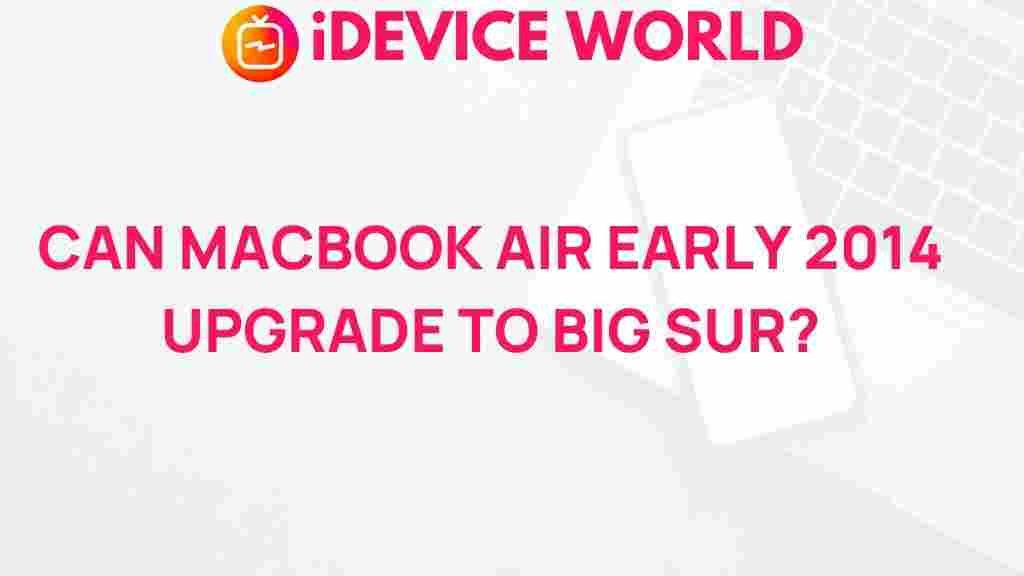MacBook Air: Unveiling the Mystery of Upgrading to Big Sur
In the world of technology, Apple products are often at the forefront of innovation and design. Among these products, the MacBook Air has earned a special place in the hearts of many users due to its sleek design and impressive performance. However, with every new macOS release, questions arise regarding compatibility, especially for older models like the MacBook Air Early 2014. This article aims to unveil the mystery surrounding the question: Can the MacBook Air Early 2014 upgrade to Big Sur?
Understanding macOS Big Sur
macOS Big Sur, introduced by Apple in June 2020, represents a significant overhaul of the Mac operating system. It brings a fresh interface, enhanced features, and improved performance. Some of the key features include:
- Redesigned Interface: Big Sur offers a more spacious layout, a new Control Center, and updated notification features.
- Improved Safari: The browser received updates that make it faster and more secure, with enhanced privacy features.
- Messages and Maps Enhancements: These apps come with new features, making communication and navigation easier and more efficient.
- Universal Control: A feature that allows seamless control of multiple Apple devices with one mouse and keyboard.
Before diving into whether the MacBook Air Early 2014 can support this new operating system, it’s essential to check the system requirements for Big Sur.
System Requirements for macOS Big Sur
To successfully install macOS Big Sur, your device must meet specific hardware requirements:
- Supported Models: macOS Big Sur supports MacBook Air models from 2013 and later.
- Processor: A compatible Intel processor is required.
- RAM: At least 4GB of RAM is necessary, though 8GB or more is recommended for optimal performance.
- Storage: You’ll need a minimum of 35.5GB of available storage for the upgrade.
- Graphics: A Metal-capable graphics card is essential for better graphics performance.
Given that the MacBook Air Early 2014 falls under the supported model category, we can proceed to explore the upgrade process.
Step-by-Step Upgrade Process
If you’re ready to upgrade your MacBook Air Early 2014 to macOS Big Sur, follow these steps:
1. Back Up Your Data
Before making any significant changes to your system, it’s crucial to back up your data. Use Time Machine or another backup method to ensure your files are safe.
2. Check for Software Updates
Make sure your current version of macOS is updated to the latest available version. Go to the Apple menu and select About This Mac > Software Update.
3. Free Up Storage Space
Ensure you have enough storage space for the installation. You may need to delete unnecessary files or use tools like Optimize Storage to free up space.
4. Download Big Sur
Once you’re ready, go to the Apple website and download macOS Big Sur from the App Store. Click on the Get button to begin the download.
5. Install Big Sur
After the download completes, the installation will automatically start. Follow the on-screen instructions to complete the installation process.
6. Set Up After Installation
Once installed, your Mac will restart. Follow the prompts to set up your new macOS, including signing into your Apple ID and customizing your settings.
Troubleshooting Tips
Sometimes, the upgrade process may not go as smoothly as planned. Here are some troubleshooting tips to help you navigate common issues:
Issue 1: Installation Fails
If the installation fails, ensure that your MacBook Air has enough storage space and is connected to a stable internet connection. Restart your Mac and try the installation again.
Issue 2: Slow Performance After Upgrade
If you notice that your Mac is running slowly after upgrading, consider the following:
- Close unused applications to free up RAM.
- Check Activity Monitor for any applications consuming excessive resources.
- Consider resetting the SMC (System Management Controller) and PRAM/NVRAM.
Issue 3: Software Incompatibility
Some older applications may not work with macOS Big Sur. Check the software developer’s website for updates or alternative solutions.
Benefits of Upgrading Your MacBook Air
Upgrading your MacBook Air to macOS Big Sur offers several benefits:
- Enhanced Security: Big Sur comes with significant security improvements, protecting your data from vulnerabilities.
- Access to New Features: Enjoy the latest features and improvements, enhancing your overall user experience.
- Better Performance: Users often report improved system performance and battery life after upgrading.
Conclusion
In conclusion, the MacBook Air Early 2014 can indeed upgrade to macOS Big Sur, provided it meets the necessary system requirements. Following the outlined steps will ensure a smooth upgrade process, allowing you to enjoy the latest features and enhancements that Big Sur offers. However, always remember to back up your data and troubleshoot any issues that arise during the installation process. Embracing the upgrade not only enhances your device’s performance but also keeps it secure and up-to-date with the latest technological advancements. If you’re ready to dive deeper into the capabilities of your MacBook, consider exploring other features of macOS Big Sur by visiting this link.
This article is in the category Productivity and created by iDeciveWorld Team
